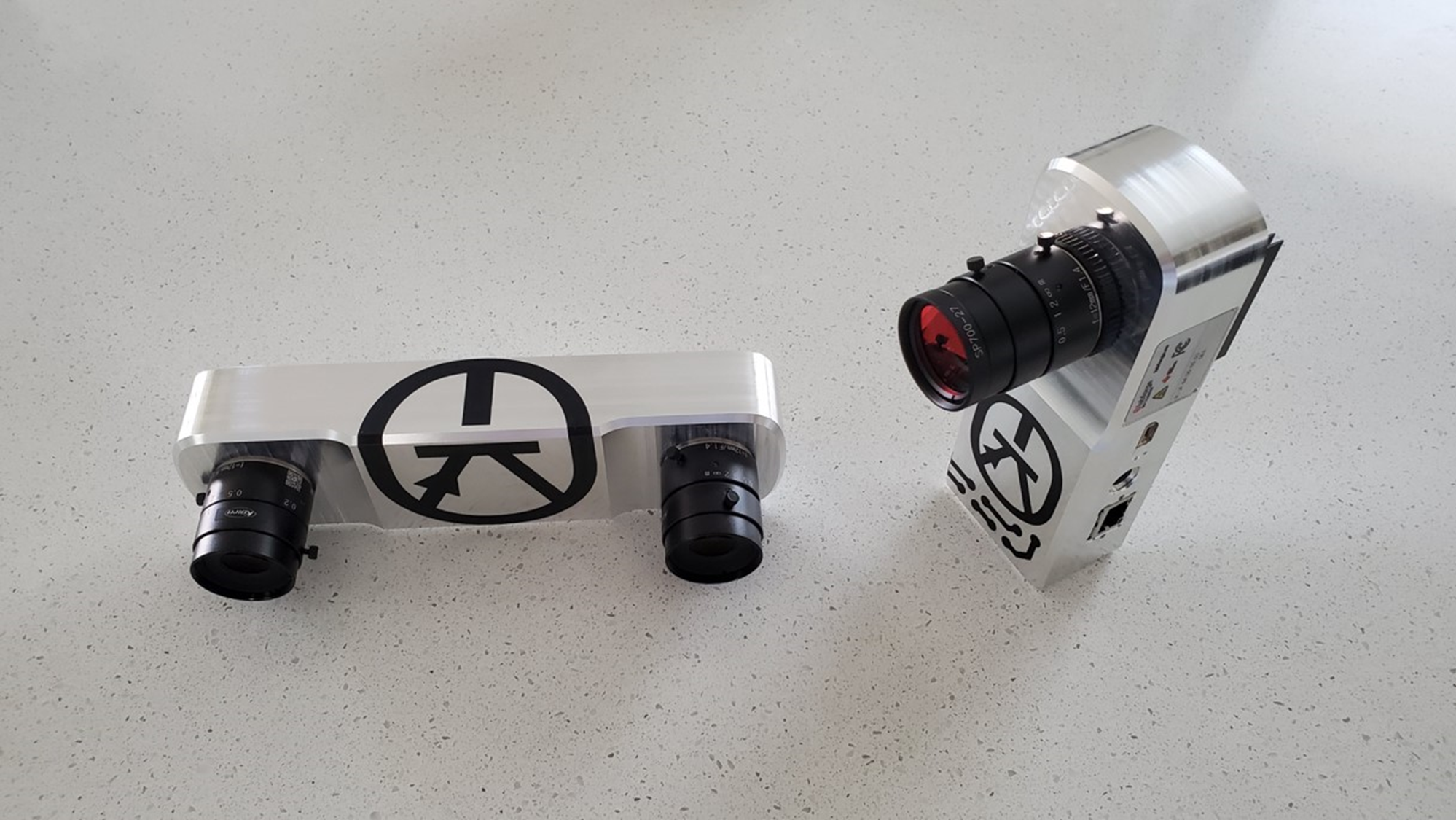Introduction
Bottlenose is a family of high-resolution smart cameras for industrial automation and robotics applications. The powerful on-camera ISP, acceleration for feature point detection & matching, depth, and AI are accessible via GigE Vision parameters.

Bottlenose stereo on the left and monocular on the right. Fitted with Kowa lenses and a Midopt IR filter.
Overview
Bottlenose is available in both a stereo and monocular version. The stereo version includes dual image sensors, and both monocular and stereo versions have hardware-synchronized triple-axis gyroscopes, accelerometers, and magnetometers. Bottlenose can be connected over standard ethernet using GigE Vision 2.1.
The CS-lens mount allows users to configure their solution with CS format lenses or with the use of an adapter C, or S-mount lenses allowing for a wide range of focal length and field of view options.
Bottlenose Technical Highlights
Depth Computation
- 3.5TOPS Computing Power
- Semi-Global Matching (SGM) @ 200MP/s
- SGM + un-distortion + rectification @ 32MP/s to 48MP/s
Bottlenose computes the Semi-Global Matching (SGM) algorithm at up-to 4K resolution with an incredibly fast 200+ MP/s internal throughput. Customers can compute depth at faster rates, wider angles, and/or longer range. Results are output as rectified disparity images.
AI
- 2.5TOPS Computing Power (NN Accelerator + DSP)
- 16-bit FP NN Support
- 4GB LPDDR4
Bottlenose has hardware acceleration for neural network models including YOLOv3, SSD, and others. There is plenty of memory with 4GB of onboard LP-DDR4 and 320MB of flash storage for large model sizes. No need for quantization and pruning of the models.
Dual ISP + Affine Accelerator
- 9TOPS Computing Power
- Demosaic, AWB, CCM, HDR, LTM
- Stereo rectification, un-distortion
The powerful on-camera ISP allows for high quality images. It reduces noise, corrects defects, and demosaics raw images.
On-camera HDR (High Dynamic Range) is a breeze for Bottlenose. It combines low, mid, and high exposure image frames to excel in complex lighting situations.
Point Cloud Generation
- 4.7TOPS Computing Power
- Corner Detection via FAST and GFTT
- A-KAZE Descriptors and Hamming Distance Matching
Bottlenose computes corner points in the left and right images using FAST and GFTT algorithms. Feature descriptors are calculated via A-KAZE and matched using Hamming distance.
Output is communicated via GigE Vision’s built-in methods or a secondary meta-data stream. This communication protocol is in active development and we are open to user preferences. Please contact us.
Customers can use this front-end processing result to build their own pick & place, automated harvesting, SLAM, navigation, and obstacle avoidance solutions.
Applications for Bottlenose include:
- Industrial Automation
- Manufacturing
- Food & beverage processing
- 3D machine vision
- Industrial IoT
- Object detection
- Object classification
- Robotics
- AgTech
- Service robots
- Delivery robots
- Warehouse robots
- Assistive devices
- Healthcare robots
- Localization
- 3D scanning
- Defense & Security
- VRU detection
- Human and animal biomechanics
- Gait analysis
Warranty
Any changes or modifications to the hard- and/or software not expressly approved by Labforge Inc. will void the user’s warranty.
Information on Disposal
The Labforge Bottlenose cameras cannot be treated as household waste. Please contact your local authority or household waste disposal service provider to learn about proper disposal in your area.
Glossary
A-KAZE - is Accelerated-KAZE which is a feature detection and extraction algorithm.
DNN - stands for Deep Neural Network. A DNN is an artificial neural network with multiple layers between the input and output layers.
FAST - stands for Features from Accelerated Segment Test which is a corner detection method that can be used to extract feature points.
GFTT - Good Features To Track is a feature detection algorithm.
Gigabit Ethernet is the term applied to transmitting Ethernet frames at a rate of a gigabit per second.
GigE Vision - GigE Vision® is a global camera interface standard developed using the Gigabit Ethernet communication protocol for configuring cameras and transmitting images.
Hamming Distance - is a metric for comparing two binary data strings and is used for error correction.
IMU - is an Inertial Measurement Unit. It consists of accelerometers (to measure inertial acceleration), gyroscopes (to measure and report angular rate), and a magnetometer (to measure the surrounding magnetic field).
SDK - is a Software Development Kit. An SDK is a collection of software development tools in one installable package.
SGM - Semi-Global Matching is a computer vision algorithm for the estimation of a dense disparity map from a pair of rectified stereo images.
SLAM - Simultaneous Localization and Mapping is often used in robotic navigation and mapping as it is the process of creating a map of an unknown environment while simultaneously keeping track of the sensor's location within it.
Updated 2 months ago